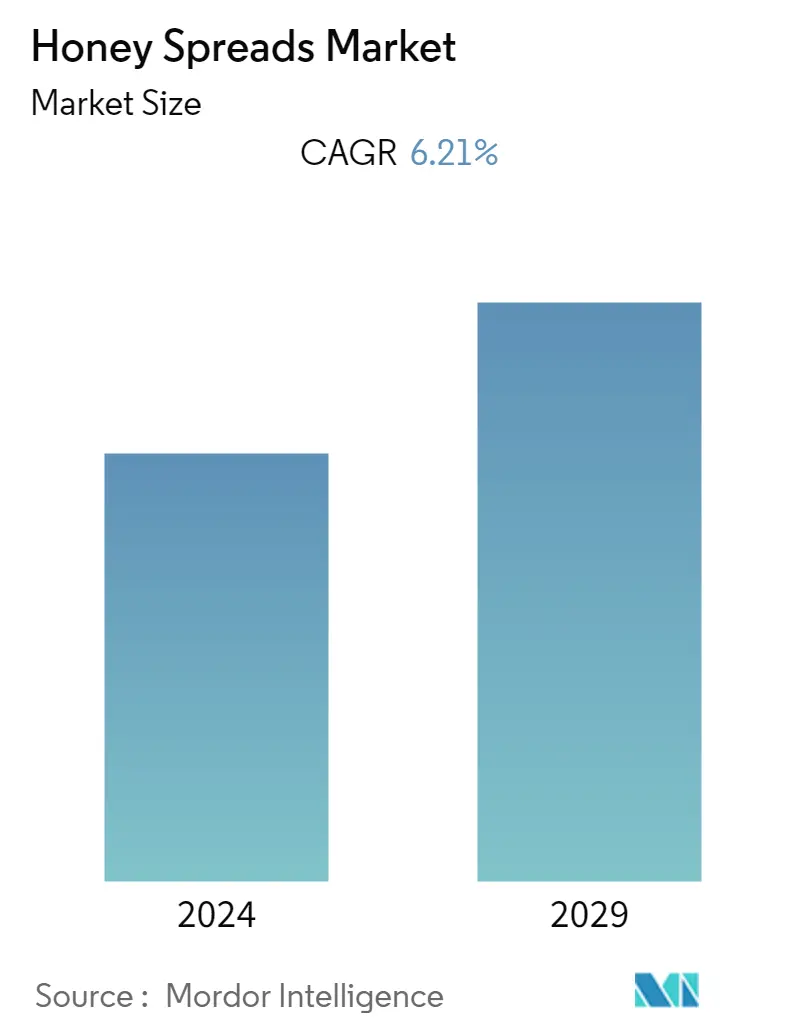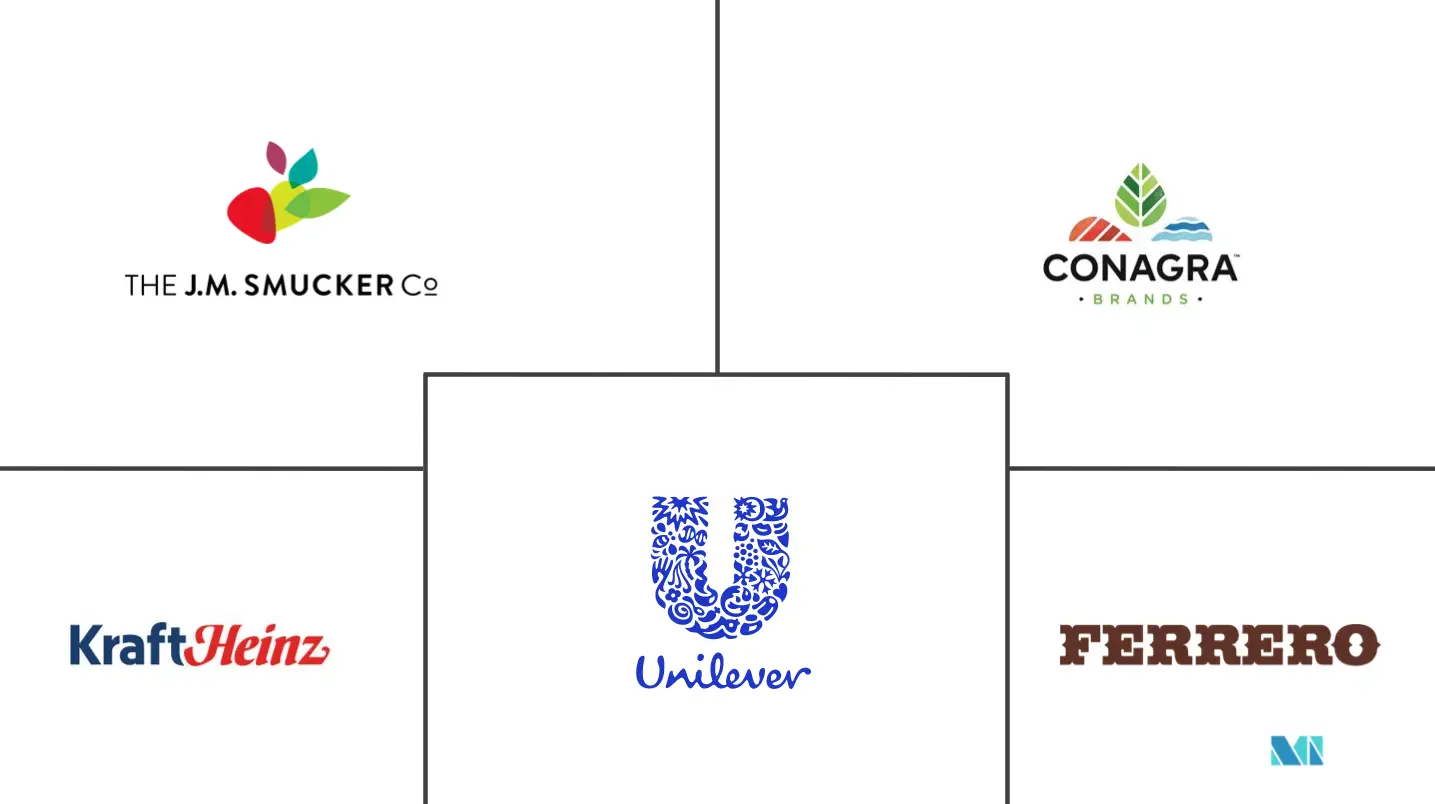Market Size of Honey Spreads Industry

| Study Period | 2019 - 2029 |
| Base Year For Estimation | 2023 |
| CAGR | 6.21 % |
| Fastest Growing Market | Europe |
| Largest Market | North America |
| Market Concentration | Medium |
Major Players
*Disclaimer: Major Players sorted in no particular order |
Honey Spreads Market Analysis
The honey spread market is projected to register a CAGR of 6.21% during the forecast period, 2022-2027.
Honey has witnessed a higher demand among consumers as it is widely used as a natural sweetener in food products. The honey spread has been used as a staple of breakfast foods in the western region and its popularity is growing across the world which in turn boosted the market growth over the past few years. However, the outbreak of the COVID-19 pandemic impacted the honey spread market in the financial year 2020-21 due to the lack of resources and disruption in the supply chain which in turn affected the production rate.
Over the long term, the market growth can be attributed to the rising consumption of honey, and honey spread among consumers as it is abundant in nutrition such as vitamins, minerals, and natural sugar. In addition, the honey spread is primarily replacing the table sugar in daily diet owing to its various nutritional and health benefits such as cholesterol-free, fat-free, and aid in curing digestive health issues and enhancing immune function. Moreover, the rising consumer health consciousness has changed their preference for sweeteners from artificial sweeteners to natural sweeteners and hence, driving the sales of honey spread in the worldwide market over the forecast period.
Honey Spreads Industry Segmentation
Honey spread is a type of food spread containing honey as a key ingredient and can be used in different food products such as bread slices, waffles, pancakes, and muffins. The global honey spread market (henceforth referred to as the market studied) is segmented by product type, distribution channel, and geography. By product type, the market is segmented into pure honey spread, nut honey spread, mixed honey spread, and others. Based on the distribution channel, the market is segmented into supermarkets/hypermarkets, convenience stores, online retail stores, and other distribution channels. It provides an analysis of emerging and established economies across the world, comprising North America, Europe, South America, Asia-Pacific, the Middle East, and Africa. For each segment, the market sizing and forecasts have been done on the basis of value (in USD million).
| By Product Type | |
| Pure Honey Spread | |
| Nut Honey Spread | |
| Mixed Honey Spread | |
| Others |
| By Distribution Channel | |
| Supermarkets/Hypermarkets | |
| Convenience Stores | |
| Online Retail Stores | |
| Other Distribution Channels |
| By Geography | |||||||||
| |||||||||
| |||||||||
| |||||||||
| |||||||||
|
Honey Spreads Market Size Summary
The honey spread market is experiencing significant growth, driven by increasing consumer demand for natural sweeteners. Honey spreads are becoming a staple in breakfast foods, particularly in Western regions, and their popularity is expanding globally. This trend is fueled by the nutritional benefits of honey, which is rich in vitamins, minerals, and natural sugars, making it a healthier alternative to table sugar. The shift in consumer preference from artificial to natural sweeteners, due to rising health consciousness, is further propelling the market. The COVID-19 pandemic initially disrupted supply chains, impacting production, but the long-term outlook remains positive as consumers continue to seek healthier dietary options.
North America is expected to lead the honey spread market, with the United States showing a particularly high demand for honey-based products. The region's growing consumption of honey spreads in breakfast foods is encouraging companies to introduce new varieties to cater to this demand. The market is competitive, with major players like Kraft Heinz, J M Smucker Company, and Ferrero International actively engaging in product innovations and strategic mergers to expand their market presence. The introduction of flavored honey spreads and products like honey-based peanut butter and walnut honey butter highlights the ongoing innovation in the sector, aiming to meet the evolving preferences of health-conscious consumers.
Honey Spreads Market Size - Table of Contents
-
1. MARKET DYNAMICS
-
1.1 Market Drivers
-
1.2 Market Restraints
-
1.3 Porter's Five Force Analysis
-
1.3.1 Threat of New Entrants
-
1.3.2 Bargaining Power of Buyers/Consumers
-
1.3.3 Bargaining Power of Suppliers
-
1.3.4 Threat of Substitute Products
-
1.3.5 Intensity of Competitive Rivalry
-
-
-
2. MARKET SEGMENTATION
-
2.1 By Product Type
-
2.1.1 Pure Honey Spread
-
2.1.2 Nut Honey Spread
-
2.1.3 Mixed Honey Spread
-
2.1.4 Others
-
-
2.2 By Distribution Channel
-
2.2.1 Supermarkets/Hypermarkets
-
2.2.2 Convenience Stores
-
2.2.3 Online Retail Stores
-
2.2.4 Other Distribution Channels
-
-
2.3 By Geography
-
2.3.1 North America
-
2.3.1.1 United States
-
2.3.1.2 Canada
-
2.3.1.3 Mexico
-
2.3.1.4 Rest of North America
-
-
2.3.2 Europe
-
2.3.2.1 United Kingdom
-
2.3.2.2 Germany
-
2.3.2.3 Spain
-
2.3.2.4 France
-
2.3.2.5 Italy
-
2.3.2.6 Russia
-
2.3.2.7 Rest of Europe
-
-
2.3.3 Asia-Pacific
-
2.3.3.1 China
-
2.3.3.2 Japan
-
2.3.3.3 India
-
2.3.3.4 Australia
-
2.3.3.5 Rest of Asia-Pacific
-
-
2.3.4 South America
-
2.3.4.1 Brazil
-
2.3.4.2 Argentina
-
2.3.4.3 Rest of South America
-
-
2.3.5 Middle East & Africa
-
2.3.5.1 Saudi Arabia
-
2.3.5.2 South Africa
-
2.3.5.3 Rest of Middle East & Africa
-
-
-
Honey Spreads Market Size FAQs
What is the current Honey Spreads Market size?
The Honey Spreads Market is projected to register a CAGR of 6.21% during the forecast period (2024-2029)
Who are the key players in Honey Spreads Market?
unilever plc , The Kraft Heinz Company, Conagra Brands, Inc., J M Smucker Company and Ferrero International S.A. are the major companies operating in the Honey Spreads Market.

